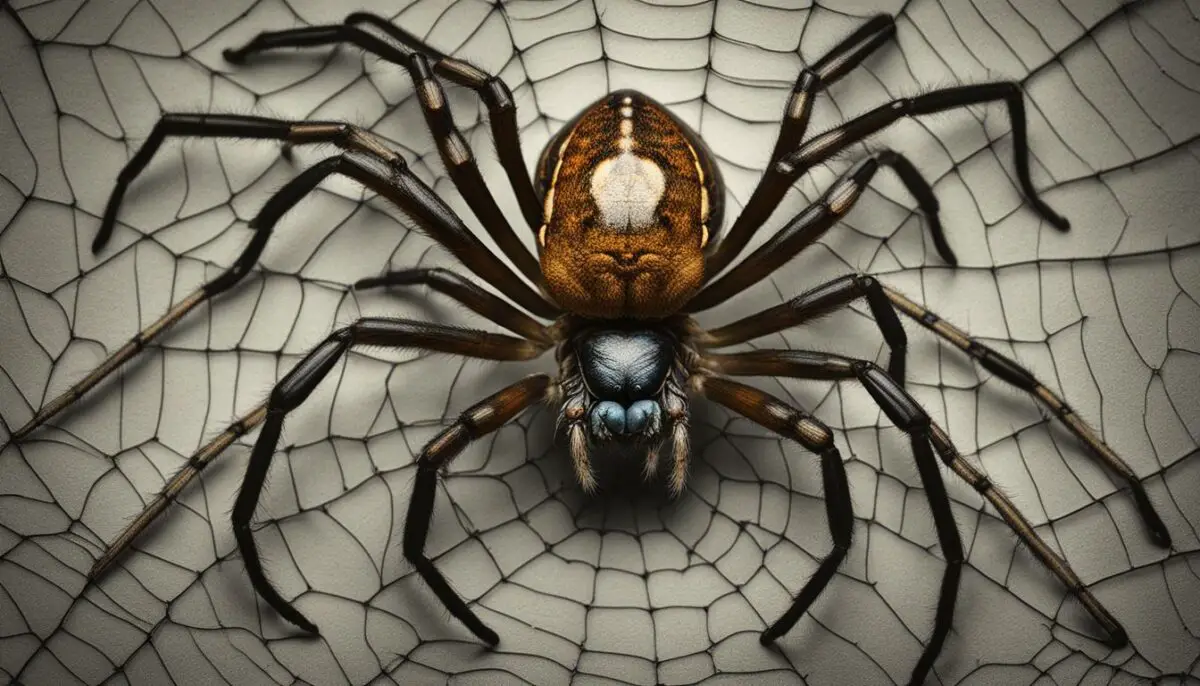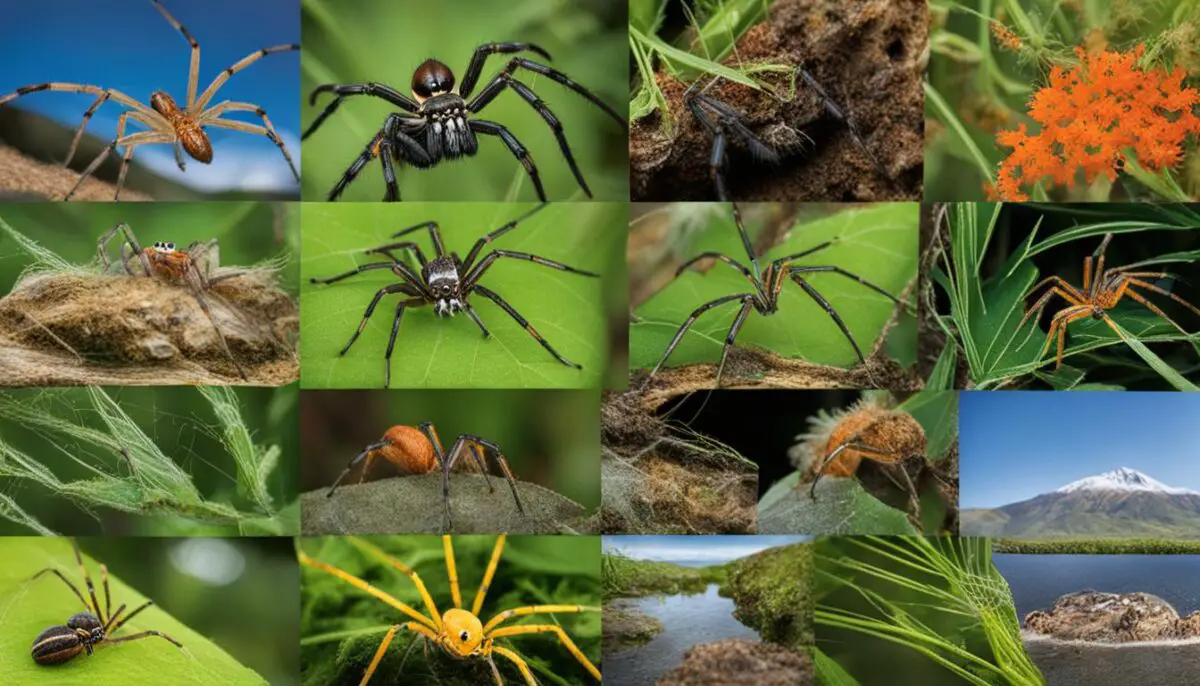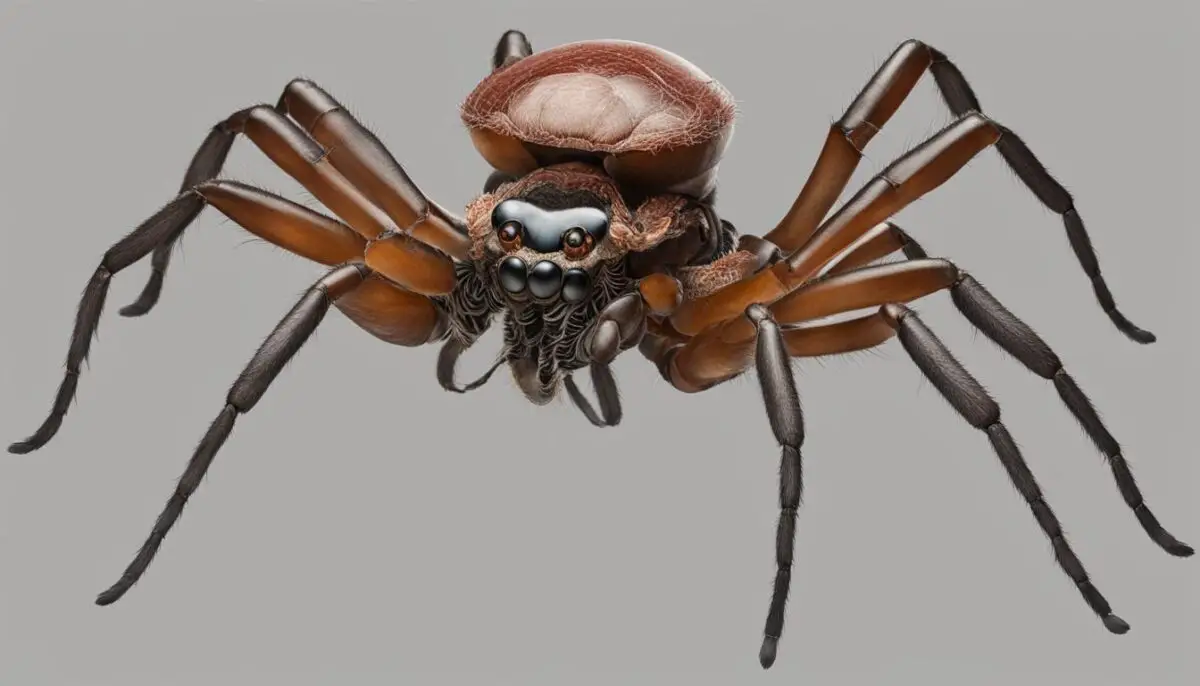Spiders are fascinating creatures, known for their eight legs and intricate webs. But have you ever wondered just how many spiders there are in the world? In this article, we will delve into the global spider population, exploring the number of spiders worldwide, different spider species, and interesting spider facts and statistics. Get ready to embark on a journey of spider data analysis and uncover the secrets of these remarkable arachnids.
Key Takeaways:
- There is a vast global population of spiders, but calculating the exact number is challenging.
- Spider species vary in size, habitat, and behavior, contributing to the overall arachnid population.
- Spider data analysis provides valuable insights into the distribution and characteristics of different spider species.
- Understanding spider facts and statistics can help us appreciate the diversity and complexity of the spider world.
- Stay tuned for more fascinating information on spiders and their role in the ecosystem.
How Much Spiders Are There in the World
The Exceptionality of Six-legged Spiders
Six-legged spiders, although rare, exhibit a fascinating exceptionality within the arachnid world. These spiders do not belong to a distinct species but rather arise as a result of certain circumstances such as predation, injury, or molting issues. Despite their leg loss, they possess the remarkable ability to function and survive well in their environments. Let’s dive deeper into the differences between six-legged and eight-legged spiders to understand their unique adaptations and leg count.
When comparing six-legged and eight-legged spiders, the primary distinction lies in their leg count. While eight-legged spiders possess the typical and symmetrical eight legs, six-legged spiders have, on average, two fewer legs due to leg loss. This reduction in leg count does not hinder their mobility significantly, as they are still capable of moving efficiently, hunting for prey, and navigating their habitats with agility. how much spiders are there in the world
It is crucial to note that six-legged spiders are not a separate species but rather a variation within existing spider species. These variations can occur due to various factors, such as injuries caused by predators or accidents. Additionally, molting issues can lead to leg loss during the spider’s growth process. Despite the differences in leg count, six-legged spiders are able to adapt and thrive in their environments, displaying remarkable resilience and providing valuable insights into arachnid adaptations.
The Leg Count in Six-legged and Eight-legged Spiders
| Six-legged Spiders | Eight-legged Spiders | |
|---|---|---|
| Leg Count | 6 legs | 8 legs |
| Mobility | Efficient movement and agility | Efficient movement and agility |
| Adaptation | Resilient and able to thrive | Resilient and able to thrive |
General Anatomy of Six-legged Spiders
Six-legged spiders possess a similar anatomical structure to their eight-legged counterparts. The body of a spider consists of two main parts: the cephalothorax and the abdomen. The cephalothorax is the fused head and thorax region and houses important organs such as the spider’s eyes, mouthparts, and six legs. It is the central hub of sensory perception and locomotion for these fascinating arachnids. The abdomen, on the other hand, contains the spider’s vital organs, including those responsible for digestion and reproduction. It is important to note that while the number of legs differs, the rest of the anatomy remains largely the same. global spider count
The six legs of a six-legged spider play a crucial role in its mobility and survival. These appendages are jointed, allowing for a wide range of movement and agile navigation of various terrains. The legs are equipped with tiny sensory hairs that enable spiders to detect vibrations from their surroundings, aiding in their ability to locate prey and avoid potential threats. Despite having fewer legs, six-legged spiders have adapted remarkably well to their unique anatomical structure, showcasing their resilience and adaptive capabilities.

Table: Comparison of Anatomy Between Six-legged and Eight-legged Spiders
| Body Part | Six-legged Spiders | Eight-legged Spiders |
|---|---|---|
| Cephalothorax | Contains eyes, mouthparts, and six legs | Contains eyes, mouthparts, and eight legs |
| Abdomen | Houses organs for digestion and reproduction | Houses organs for digestion and reproduction |
| Total Legs | Six | Eight |
| Mobility | Agile movement with six jointed legs | Agile movement with eight jointed legs |
| Sensory Perception | Six legs equipped with sensory hairs | Eight legs equipped with sensory hairs |
As demonstrated in the table above, the primary distinction between six-legged and eight-legged spiders lies in the leg count. Despite this difference, six-legged spiders are still capable of functioning and thriving within their environments. Their anatomy reflects their ability to adapt to their circumstances and showcases the incredible diversity within the arachnid world. spider infographic
Visual Features of Six-legged Spiders
Six-legged spiders exhibit a diverse range of visual features that make them truly unique. These features include various eye patterns, colors, and pigmentation that distinguish them from their eight-legged counterparts. One distinct characteristic is their eye pattern, which typically consists of eight eyes arranged in two rows of four. This allows them to have a wide field of vision and detect potential prey or predators from multiple angles.
When it comes to colors and patterns, six-legged spiders can display a wide spectrum of variations. Some species may exhibit vibrant colors, while others may have intricate patterns on their bodies. These visual features can serve multiple purposes, including camouflage, attracting mates, or warning predators of their toxicity. It’s fascinating to observe the intricate designs and hues that nature has bestowed upon these arachnids. spider statistics
Interestingly, there are also instances where six-legged spiders appear albino due to a genetic mutation that affects their pigmentation. These albino spiders lack the typical coloration and appear pale or translucent. They can be quite rare and captivating to observe, as their unique appearance sets them apart from other spiders in their environment.
Table: Comparing Visual Features of Six-legged and Eight-legged Spiders
| Visual Features | Six-legged Spiders | Eight-legged Spiders |
|---|---|---|
| Eye Patterns | Two rows of four eyes | Two rows of four to eight eyes |
| Colors and Patterns | Varies widely, vibrant colors and intricate patterns | Varies widely, vibrant colors and intricate patterns |
| Albinism | Occasionally albino due to genetic mutation | Occasionally albino due to genetic mutation |
In conclusion, six-legged spiders possess fascinating visual features that make them stand out in the world of arachnids. From their unique eye patterns to a wide array of colors and the occasional occurrence of albino individuals, these spiders showcase the incredible diversity and beauty found in nature.
Unusual Movement Capabilities of Six-legged Spiders
Six-legged spiders may have fewer legs compared to their eight-legged counterparts, but they possess unique movement capabilities that allow them to navigate their environments with agility and precision. Despite the loss of legs, these arachnids can still exhibit impressive mobility, including jumping, climbing, and running. Let’s explore these fascinating abilities in more detail:
“Six-legged spiders exhibit unique movement abilities, such as the ability to jump several times their body length and climb surfaces effectively.”
Jumping spiders, a subgroup of six-legged spiders, are known for their incredible leaping skills. Using their strong leg muscles, they can propel themselves several times their body length, allowing them to quickly capture prey or evade potential threats. This remarkable jumping ability is attributed to the unique structure and flexibility of their legs.
In addition to their jumping prowess, six-legged spiders possess impressive climbing abilities. Their legs are equipped with microscopic hairs that act as tiny hooks, enhancing their grip on various surfaces. These adhesive hairs enable them to scale vertical surfaces, such as walls or tree trunks, with ease.
Despite having two fewer legs, six-legged spiders can still achieve impressive running speeds. Their remaining legs compensate for the loss, allowing them to move swiftly to capture prey or escape from predators. This ability highlights their adaptability and resourcefulness in navigating their surroundings.
| Movement Abilities | Description |
|---|---|
| Jumping | Six-legged spiders can leap several times their body length, thanks to their strong leg muscles and unique leg structure. |
| Climbing | Microscopic hairs on their legs enable six-legged spiders to climb vertical surfaces effectively. |
| Running | Despite having fewer legs, six-legged spiders can still achieve impressive running speeds to capture prey or escape from predators. |
Overall, the unusual movement capabilities of six-legged spiders demonstrate their ability to adapt and thrive in their environments, showcasing the remarkable versatility of these arachnids despite their leg loss. Their jumping, climbing, and running skills contribute to their survival and success as skilled hunters in the arachnid world.

Unusual Movement Capabilities of Six-legged Spiders
Diet and Hunting Techniques of Six-legged Spiders
Six-legged spiders, like their eight-legged counterparts, have a predominantly carnivorous diet. They feed on a variety of insects, including flies, ants, beetles, and smaller spiders. Despite having fewer legs, six-legged spiders have developed unique hunting techniques to catch their prey effectively.
Jumping spiders, known for their agility and excellent eyesight, use their powerful legs to pounce on unsuspecting insects. They rely on their quick reflexes and precise movements to capture their prey. These spiders are ambush predators, often patiently waiting for their target to come within striking distance before launching their attack.
Web-spinning spiders, on the other hand, utilize their silk-spinning abilities to construct intricate webs in strategic locations. These webs act as traps, ensnaring insects that unknowingly stumble into them. The spider then immobilizes its trapped prey with a quick bite before consuming it.
To summarize, the diet of six-legged spiders consists primarily of insects, and they employ various hunting techniques such as jumping and ambushing or constructing webs to catch their prey effectively. Despite having fewer legs, these spiders have adapted their hunting strategies to compensate for their reduced limb count, showcasing their remarkable abilities as skilled predators.
| Spider Species | Diet | Hunting Techniques |
|---|---|---|
| Jumping Spiders | Insects (flies, ants, beetles, smaller spiders) | Jumping, ambushing |
| Web-spinning Spiders | Insects (flies, mosquitoes, moths) | Web construction, ensnaring, biting |
Habitats and Survival of Six-legged Spiders
Six-legged spiders, despite their reduced number of legs, are remarkably adaptable creatures that can thrive in a variety of habitats. They have developed unique survival strategies to overcome challenges posed by warm climates, rough conditions, and even human-made environments such as homes and yards.
In warm climates, six-legged spiders have evolved to withstand higher temperatures and lower humidity levels. They are often found in regions with tropical or desert-like conditions, where they have adapted to the hot and arid environment. Their ability to conserve water and regulate their body temperature enables them to survive and reproduce in these challenging habitats.
When facing rough conditions such as extreme weather events or natural disasters, six-legged spiders demonstrate remarkable resilience. They have the ability to seek shelter in crevices, burrows, or vegetation, protecting themselves from harsh winds, heavy rain, or intense heat. Their small size and agile bodies allow them to navigate these rough conditions and ensure their survival.
Additionally, six-legged spiders have shown an impressive capacity to adapt to human-made environments. They can be found in homes, gardens, and yards, where they make use of available resources to build their webs or hunt for prey. These adaptable spiders may modify their hunting strategies and behavior to navigate human-altered landscapes, showcasing their ability to coexist with humans.
Examples of Six-legged Spider Habitats
While six-legged spiders can be found in various habitats, here are a few examples of their preferred environments:
- Deserts: Many six-legged spiders have adapted to survive in desert regions, where they are capable of withstanding extreme heat, limited water availability, and sandy terrain.
- Urban Environments: Certain species of six-legged spiders have successfully colonized cities and towns, utilizing buildings, gardens, and other man-made structures as their habitats.
- Forests: Some six-legged spiders thrive in forested areas, taking advantage of the abundance of prey and vegetation for shelter and web-building purposes.
Overall, the habitats and survival strategies of six-legged spiders demonstrate their remarkable ability to adapt to diverse and challenging conditions. From the sweltering heat of deserts to the bustling urban landscapes, these arachnids continue to thrive and contribute to their ecosystems.
| Habitat | Main Characteristics |
|---|---|
| Deserts | Hot and arid conditions, limited water availability, sandy terrain |
| Urban Environments | Man-made structures, gardens, access to prey |
| Forests | Abundant vegetation, diverse prey, sheltered areas for web-building |

“Six-legged spiders have successfully adapted to a wide range of habitats, including deserts, urban environments, and forests. Their ability to withstand harsh conditions and coexist with humans is a testament to their resilience and adaptability.”
Specific Spider Species with Six Legs
Six-legged spiders may not be the norm, but there are certain spider species that can exhibit this fascinating variation. Let’s take a closer look at some of the well-known spider species that may have individuals with six legs:
| Spider Species | Common Name | Leg Count |
|---|---|---|
| Tarantula | (Family: Theraphosidae) | Six or Eight Legs |
| Black Widow | (Genus: Latrodectus) | Six or Eight Legs |
| Brown Recluse | (Genus: Loxosceles) | Six or Eight Legs |
| Jumping Spider | (Family: Salticidae) | Six or Eight Legs |
These spider species are known for their unique characteristics and behaviors. While most individuals have the typical eight legs, some individuals within these species may have lost a leg due to injury or other factors. It’s important to note that the leg count can vary even within the same species.
“It’s intriguing to observe the adaptability of these spider species,” says Dr. Arachno, an expert in arachnology.
Whether they have six or eight legs, these spiders are masters of their environments and play crucial roles in maintaining natural balance.
Understanding the variations in leg count among spider species helps us appreciate the diversity and resilience of these incredible arachnids. So, the next time you come across a spider with six legs, remember that it’s just another example of nature’s ability to surprise us.
Understanding Spiders with Seven Legs
While most spiders have eight legs, there are certain cases where a spider may lose a leg in its lifetime, leaving it with only seven legs. These unique creatures are part of the arachnid family, which includes other joint-legged invertebrates like scorpions, mites, ticks, and harvestmen. Despite having one fewer leg than their eight-legged counterparts, spiders with seven legs are remarkable in their adaptability and survival abilities.
Spiders with seven legs share similar anatomy with their eight-legged counterparts, including a cephalothorax, abdomen, and seven legs. Their body parts are essential for their everyday functions, such as locomotion, hunting, and reproduction. While they may have one leg less, they can still navigate their environment and catch prey effectively.
Arachnid Characteristics and Abilities
As arachnids, spiders with seven legs possess certain distinct characteristics and abilities. They have chitinous exoskeletons that provide protection and support for their bodies. Their legs are equipped with specialized sensory structures like hairs and spines, which help them detect vibrations and capture prey. These spiders also have venom glands that they use to inject venom into their prey to immobilize or digest them.
Spiders with seven legs play an important role in controlling insect populations. They contribute to the delicate balance of ecosystems by preying on pests and maintaining the populations of other arthropods in check. Their ability to adapt and survive with one fewer leg demonstrates the resilience and ingenuity of nature.
| Arachnid Characteristics | Arachnid Abilities |
|---|---|
| Chitinous exoskeleton | Venom injection |
| Sensory structures on legs | Catching prey |
| Adaptability | Controlling insect populations |

| Comparison between Seven-Legged and Eight-Legged Spiders | Seven-Legged Spiders | Eight-Legged Spiders |
|---|---|---|
| Anatomy | Seven legs | Eight legs |
| Mobility | Can still move effectively | Full range of movement |
| Survival | Resilient and adaptable | Resilient and adaptable |
| Ecological Role | Contribute to insect control | Contribute to insect control |
Unique Adaptations of Seven-Legged Spiders
Despite their anatomical difference, seven-legged spiders possess unique adaptations that allow them to adapt and thrive. These adaptations may include enhanced sensory abilities, increased agility, or modified hunting techniques. By utilizing their remaining legs and making the most of their capabilities, seven-legged spiders continue to play a vital role in the arachnid world.
Conclusion
The world of spiders is truly fascinating, with its diverse range of species and unique adaptations. From six-legged spiders to seven-legged spiders, these arachnids have found ways to thrive despite their leg loss. Understanding their behavior and anatomy allows us to appreciate their resilience and contribution to controlling insect populations.
The spider life cycle involves intricate mating rituals, where pheromones play a crucial role in attracting potential mates. These chemical signals help spiders communicate and navigate the complex world of courtship. Additionally, web-based communication is another important aspect of spider behavior, as they use their silk to construct intricate webs for prey capture and territory marking.
As we delve deeper into the world of spiders, we gain a better understanding of their unique adaptations and survival strategies. By respecting and appreciating these fascinating creatures, we can coexist harmoniously with them and continue to marvel at their incredible abilities.
FAQ
Are six-legged spiders a separate species?
No, six-legged spiders are not a distinct species. They are a result of certain circumstances such as predation, injury, or molting issues.
How do six-legged spiders differ from eight-legged spiders?
The primary differences between six-legged and eight-legged spiders lie in their leg count, mobility, and natural occurrence.
What is the anatomy of six-legged spiders?
Six-legged spiders have similar anatomy to eight-legged spiders, consisting of a cephalothorax, abdomen, and appendages.
Do six-legged spiders have unique visual features?
Yes, six-legged spiders can exhibit a diverse range of visual features, including various eye patterns, colors, and pigmentation.
How do six-legged spiders move without all their legs?
Despite having fewer legs, six-legged spiders can still move effectively and exhibit abilities such as jumping and climbing.
What do six-legged spiders eat?
Six-legged spiders, like their eight-legged counterparts, are predominantly carnivorous and feed on various insects.
Where can six-legged spiders be found?
Six-legged spiders are adaptable and can survive in various habitats, including warm climates, homes, and yards.
Which spider species may exhibit the six-legged variation?
Well-known spider species that may show the six-legged variation include tarantulas, black widows, brown recluses, and jumping spiders.
Do spiders ever have seven legs?
Yes, there are instances where spiders may lose a leg in their lifetime, leaving them with only seven legs.
How do seven-legged spiders compare to other arachnids?
Seven-legged spiders are part of the arachnid family, which includes other joint-legged invertebrates like scorpions, mites, ticks, and harvestmen.
